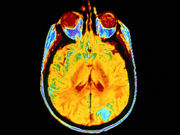For comatose survivors of out-of-hospital cardiac arrest, xenon + hypothermia tops hypothermia alone
TUESDAY, March 15, 2016 (HealthDay News) — For comatose survivors of out-of-hospital cardiac arrest, inhaled xenon combined with hypothermia is associated with less white matter damage, as measured by fractional anisotropy on magnetic resonance imaging (MRI), according to a study published in the March 15 issue of the Journal of the American Medical Association.
Ruut Laitio, M.D., Ph.D., from the University of Turku in Finland, and colleagues examined the effect of inhaled xenon on ischemic white matter damage assessed with MRI in a phase 2 trial. One hundred ten comatose patients who had experienced out-of-hospital cardiac arrest were randomized to receive inhaled xenon combined with hypothermia for 24 hours or hypothermia treatment alone (55 in each group). MRI data were available for 97 patients at a median of 53 hours after cardiac arrest.
The researchers found that the mean global fractional anisotropy values were 0.433 and 0.419 in the xenon and control groups, respectively; after adjustment for age, sex, and site, the mean global fractional anisotropy value was 3.8 percent higher in the xenon group (P = 0.006). Seventy-five patients (68.2 percent) were alive at six months. There were no significant between-group differences noted in secondary end points (neurologic outcome assessed using the modified Rankin Scale and mortality) at six months.
“These preliminary findings require further evaluation in an adequately powered clinical trial designed to assess clinical outcomes associated with inhaled xenon among survivors of out-of-hospital cardiac arrest,” the authors write.
Several authors disclosed financial ties to pharmaceutical companies, including the Neuroprotexeon Company, which intends to commercialize the use of xenon for ongoing neurologic injury.
Copyright © 2016 HealthDay. All rights reserved.








